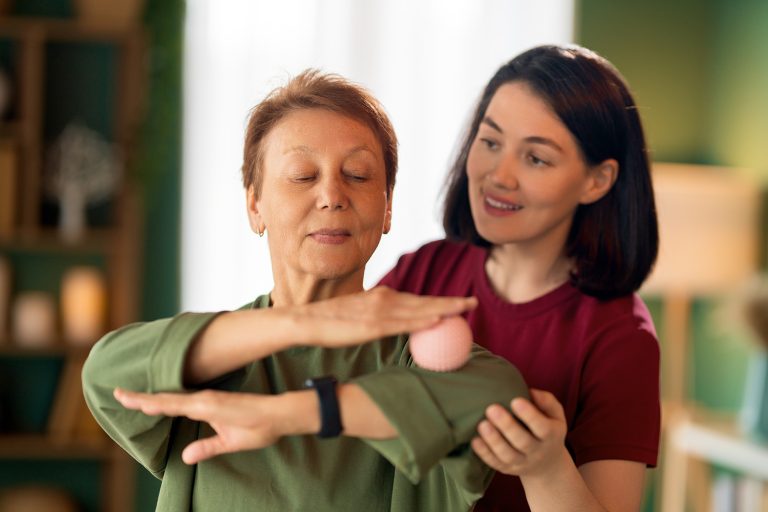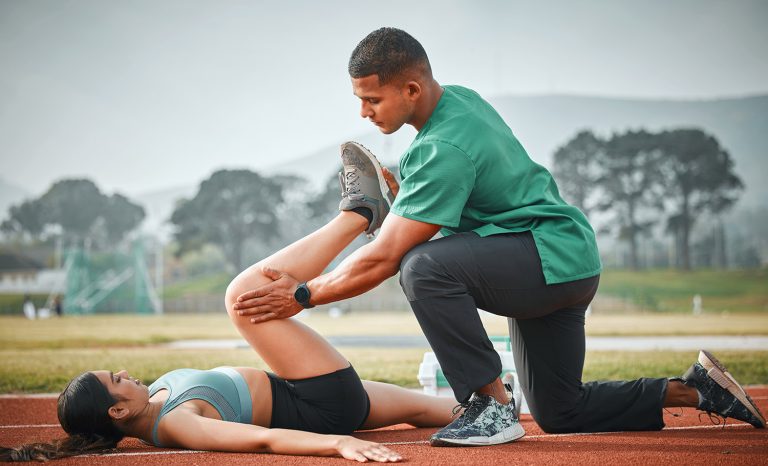

The Role of Sports Therapy in Injury Prevention
How to Stay in the Game Longer
In the world of athletics, staying in peak condition is crucial for success. Whether you’re a weekend warrior, an amateur enthusiast, or a professional athlete, you want to perform at your best while avoiding injuries that can sideline your progress. Often, when athletes think of physical therapy, they associate it with rehabilitation after an injury. However, sports therapy can serve a proactive role in injury prevention, ensuring you stay in the game longer by addressing potential issues before they escalate.
Identifying Potential Weaknesses: Preventing Injuries Before They Happen
The foundation of effective sports therapy for injury prevention begins with identifying potential weaknesses in the body. Weaknesses don’t always mean a lack of strength; they can also refer to imbalances, tightness, or faulty movement patterns that predispose athletes to injury. Sports therapists are trained to recognize these issues, often through a combination of manual assessments, biomechanical analysis, and functional movement screenings.
For instance, a runner might experience chronic knee pain not due to a direct injury but because of tightness in the hip flexors, leading to improper alignment of the legs. A sports therapist would identify this imbalance and address it with targeted strengthening and stretching exercises. By tackling these issues early on, athletes can prevent more severe injuries, such as ligament tears, stress fractures, or tendonitis.
This proactive approach is particularly valuable for athletes who push their bodies to the limit regularly. Professional assessments allow you to address problems before they become serious enough to cause time off from training or competing.
Enhancing Flexibility and Mobility: Reducing the Risk of Strains and Sprains
Flexibility and mobility are key components of any injury prevention program. Flexibility refers to the length and elasticity of muscles, while mobility refers to the movement capacity of joints. Both are essential for athletes, as inadequate flexibility or mobility can place excessive stress on certain muscles or joints, increasing the risk of injury.
Sports therapy often incorporates dynamic stretching, functional exercises, and joint mobilizations to improve these areas. Flexibility routines tailored to the specific demands of an athlete’s sport—whether it’s rotational movements in tennis or vertical leaps in basketball—can help reduce the risk of muscle strains, sprains, and even ligament tears.
Additionally, sports therapy can focus on improving range of motion in joints. This is crucial for athletes engaged in sports that require repetitive, high-impact movements. For instance, weightlifters might benefit from increased shoulder mobility to prevent rotator cuff injuries, while soccer players could focus on hip flexibility to avoid groin strains.
By consistently working on these aspects, athletes not only reduce their injury risk but also enhance their overall performance, making their bodies more efficient during both training and competition.
Correcting Movement Patterns: Promoting Long-Term Athletic Health
Faulty movement patterns are a significant contributor to chronic injuries in athletes. These can arise from poor biomechanics, improper form, or muscular imbalances that place undue stress on certain parts of the body. Sports therapy addresses these issues by evaluating how an athlete moves during their sport.
For example, if a swimmer exhibits poor shoulder mechanics, they might be at higher risk for shoulder impingement or rotator cuff injuries. A sports therapist can correct these mechanics by identifying improper movements and providing specific exercises to retrain the body. Over time, this can lead to more efficient movement, reduced strain on the body, and a lower likelihood of injury.
Correcting movement patterns also has long-term benefits for an athlete’s career. When athletes consistently practice good form and efficient movement, they experience less wear and tear on their joints, muscles, and ligaments. This promotes longevity in their sport, allowing them to compete and train for many years without the constant worry of injury.
Strengthening the Core and Stabilizing Muscles: Building a Resilient Foundation
A crucial component of injury prevention is strengthening the core and stabilizing muscles. These muscles are responsible for maintaining balance, posture, and stability during dynamic movements. Weak core muscles can lead to improper posture, overcompensation in other muscle groups, and eventually injury.
In sports therapy, core strengthening exercises are often incorporated into injury prevention programs. These exercises focus on building stability in the hips, lower back, and abdomen, which provides a solid foundation for athletic performance. A strong core ensures that athletes can maintain proper form and alignment, even during high-intensity or high-impact activities.
For example, a soccer player with weak core muscles might compensate by overusing their quadriceps, leading to knee pain or even ligament damage. Strengthening the core not only alleviates this stress but also improves overall athletic performance, allowing athletes to move more efficiently and powerfully.
Ongoing Sports Therapy: Optimum Injury Prevention and Staying in Peak Condition for Longer
Injury prevention is not a one-time event. It requires continuous care and attention to the body’s evolving needs. Regular sports therapy sessions ensure that athletes can address any imbalances, weaknesses, or movement issues before they lead to injury. These sessions also provide an opportunity for athletes to receive expert guidance on their training regimens, ensuring that they’re optimizing their performance while minimizing injury risk.
Ultimately, sports therapy plays a vital role in keeping athletes healthy, strong, and performing at their best. By identifying weaknesses, improving flexibility and mobility, correcting movement patterns, and strengthening the core, athletes can reduce their risk of injury and extend their careers. Whether you’re a professional athlete or simply passionate about your sport, investing in sports therapy for injury prevention is one of the best ways to stay in the game longer.
Injury Prevention in Sports – Essential Tips from Professional Therapists
🏋️♂️ Recover faster and perform better with personalized Sports Therapy! At Kinetic Physical Therapy and Wellness in Greenville, NC, we specialize in helping athletes overcome injuries and reach peak performance. Our expert therapists provide individualized care designed to speed up recovery, prevent future injuries, and enhance your athletic abilities. Whether you’re dealing with a sports-related injury or looking to improve your performance, our tailored sports therapy sessions are here to support your journey. 🌟 Get back in the game stronger than ever—schedule your Sports Therapy session today and experience the power of expert care!
Please Share
categories
Recent Posts

The Role of Sports Therapy in Injury Prevention
How to Stay in the Game Longer
In the world of athletics, staying in peak condition is crucial for success. Whether you’re a weekend warrior, an amateur enthusiast, or a professional athlete, you want to perform at your best while avoiding injuries that can sideline your progress. Often, when athletes think of physical therapy, they associate it with rehabilitation after an injury. However, sports therapy can serve a proactive role in injury prevention, ensuring you stay in the game longer by addressing potential issues before they escalate.
Identifying Potential Weaknesses: Preventing Injuries Before They Happen
The foundation of effective sports therapy for injury prevention begins with identifying potential weaknesses in the body. Weaknesses don’t always mean a lack of strength; they can also refer to imbalances, tightness, or faulty movement patterns that predispose athletes to injury. Sports therapists are trained to recognize these issues, often through a combination of manual assessments, biomechanical analysis, and functional movement screenings.
For instance, a runner might experience chronic knee pain not due to a direct injury but because of tightness in the hip flexors, leading to improper alignment of the legs. A sports therapist would identify this imbalance and address it with targeted strengthening and stretching exercises. By tackling these issues early on, athletes can prevent more severe injuries, such as ligament tears, stress fractures, or tendonitis.
This proactive approach is particularly valuable for athletes who push their bodies to the limit regularly. Professional assessments allow you to address problems before they become serious enough to cause time off from training or competing.
Enhancing Flexibility and Mobility: Reducing the Risk of Strains and Sprains
Flexibility and mobility are key components of any injury prevention program. Flexibility refers to the length and elasticity of muscles, while mobility refers to the movement capacity of joints. Both are essential for athletes, as inadequate flexibility or mobility can place excessive stress on certain muscles or joints, increasing the risk of injury.
Sports therapy often incorporates dynamic stretching, functional exercises, and joint mobilizations to improve these areas. Flexibility routines tailored to the specific demands of an athlete’s sport—whether it’s rotational movements in tennis or vertical leaps in basketball—can help reduce the risk of muscle strains, sprains, and even ligament tears.
Additionally, sports therapy can focus on improving range of motion in joints. This is crucial for athletes engaged in sports that require repetitive, high-impact movements. For instance, weightlifters might benefit from increased shoulder mobility to prevent rotator cuff injuries, while soccer players could focus on hip flexibility to avoid groin strains.
By consistently working on these aspects, athletes not only reduce their injury risk but also enhance their overall performance, making their bodies more efficient during both training and competition.
Correcting Movement Patterns: Promoting Long-Term Athletic Health
Faulty movement patterns are a significant contributor to chronic injuries in athletes. These can arise from poor biomechanics, improper form, or muscular imbalances that place undue stress on certain parts of the body. Sports therapy addresses these issues by evaluating how an athlete moves during their sport.
For example, if a swimmer exhibits poor shoulder mechanics, they might be at higher risk for shoulder impingement or rotator cuff injuries. A sports therapist can correct these mechanics by identifying improper movements and providing specific exercises to retrain the body. Over time, this can lead to more efficient movement, reduced strain on the body, and a lower likelihood of injury.
Correcting movement patterns also has long-term benefits for an athlete’s career. When athletes consistently practice good form and efficient movement, they experience less wear and tear on their joints, muscles, and ligaments. This promotes longevity in their sport, allowing them to compete and train for many years without the constant worry of injury.
Strengthening the Core and Stabilizing Muscles: Building a Resilient Foundation
A crucial component of injury prevention is strengthening the core and stabilizing muscles. These muscles are responsible for maintaining balance, posture, and stability during dynamic movements. Weak core muscles can lead to improper posture, overcompensation in other muscle groups, and eventually injury.
In sports therapy, core strengthening exercises are often incorporated into injury prevention programs. These exercises focus on building stability in the hips, lower back, and abdomen, which provides a solid foundation for athletic performance. A strong core ensures that athletes can maintain proper form and alignment, even during high-intensity or high-impact activities.
For example, a soccer player with weak core muscles might compensate by overusing their quadriceps, leading to knee pain or even ligament damage. Strengthening the core not only alleviates this stress but also improves overall athletic performance, allowing athletes to move more efficiently and powerfully.
Ongoing Sports Therapy: Optimum Injury Prevention and Staying in Peak Condition for Longer
Injury prevention is not a one-time event. It requires continuous care and attention to the body’s evolving needs. Regular sports therapy sessions ensure that athletes can address any imbalances, weaknesses, or movement issues before they lead to injury. These sessions also provide an opportunity for athletes to receive expert guidance on their training regimens, ensuring that they’re optimizing their performance while minimizing injury risk.
Ultimately, sports therapy plays a vital role in keeping athletes healthy, strong, and performing at their best. By identifying weaknesses, improving flexibility and mobility, correcting movement patterns, and strengthening the core, athletes can reduce their risk of injury and extend their careers. Whether you’re a professional athlete or simply passionate about your sport, investing in sports therapy for injury prevention is one of the best ways to stay in the game longer.
Injury Prevention in Sports – Essential Tips from Professional Therapists
🏋️♂️ Recover faster and perform better with personalized Sports Therapy! At Kinetic Physical Therapy and Wellness in Greenville, NC, we specialize in helping athletes overcome injuries and reach peak performance. Our expert therapists provide individualized care designed to speed up recovery, prevent future injuries, and enhance your athletic abilities. Whether you’re dealing with a sports-related injury or looking to improve your performance, our tailored sports therapy sessions are here to support your journey. 🌟 Get back in the game stronger than ever—schedule your Sports Therapy session today and experience the power of expert care!
Please Share






